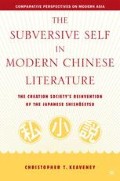Abstract
The members of the Creation Society, who were to play such vital roles in the construction of this new literature, were all young when the Society was formed in 1921, and the exuberance of their early writings was in keeping with the character of the age. Moreover, the most important of the founding members, including Guo Moruo (1892–1978), Yu Dafu (1896–1945), Zhang Ziping (1893–1959), and Cheng Fangwu (1897–1984), were all in Japan when the idea of forming a literary society was conceived. All four had been sent to Japan by the Chinese government in order to acquire practical skills, which they were expected to apply to the modernization of China upon their return. However, as with Lu Xun, Zhou Zuoren, and other writers who had preceded them to Japan as exchange students, the Creationists, in Japan during the former part of the Taishô period, came under the spell of nineteenth- and twentieth-century Western literature and decided to pursue the path of the literati (wenren)1
Access this chapter
Tax calculation will be finalised at checkout
Purchases are for personal use only
Preview
Unable to display preview. Download preview PDF.
Notes
Inaba Shoji, Iku Tappu [Yu Dafu]: Sono seishun to shi (Tokyo: Tôhô senshu, 1982), 199
Gail Bernstein, “Kawakami Hajime,” in H.D. Harootunian and Bernard S. Silberman, eds. Japan in Crisis: Essays on Taisho Democracy (Princeton, N.J.: Princeton University Press, 1974), 83
Bonnie McDougall, The Introduction of Western Literary Theories into Modern China (Tokyo: Centre for East Asian Cultural Studies, 1971), 145
Benjamin Schwartz, from the Introduction to Reflections on the May Fourth Movement (Cambridge, Mass.: Harvard University Press, 1973), 6
Irena Powell, Writers and Society in Modern Japan (Tokyo: Kodansha International Ltd., 1983), 31
Edward Fowler, The Rhetoric of Confession: Shishôsetsu in Early Twentieth Century Japanese Fiction (Berkeley, Calif.: University of California Press, 1988), 20
Noriko Mizuta Lippit, Reality and Fiction in Modern Japanese Literature (New York: MacMillan Press, 1980), 35
Tomi Suzuki, Narrating the Self: Fictions of Japanese Modernity (Stanford, Calif.: Stanford University Press, 1996), 49
Ishizaka Mikimasa, Shishôsetsu no riron: sono hôhô to kadai o megutte (Theories of the shishôsetsu: Considering Its Approaches and Themes) (Tokyo: Yachiyo shuppan, 1985), 18
Copyright information
© 2004 Christopher T. Keaveney
About this chapter
Cite this chapter
Keaveney, C.T. (2004). Shishôsetsu Theory in Japan and the Creation Society’s Encounter with the Form. In: The Subversive Self in Modern Chinese Literature. Comparative Perspectives on Modern Asia. Palgrave Macmillan, New York. https://doi.org/10.1057/9781403980984_2
Download citation
DOI: https://doi.org/10.1057/9781403980984_2
Publisher Name: Palgrave Macmillan, New York
Print ISBN: 978-1-349-52823-3
Online ISBN: 978-1-4039-8098-4
eBook Packages: Palgrave Literature & Performing Arts CollectionLiterature, Cultural and Media Studies (R0)

